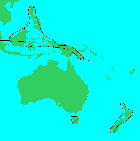|
|
Common Names
Celery top pine.Taxonomic notes
Type species Phyllocladus rhomboidalis L.C. Richard, nom. illeg. = Phyllocladus aspleniifolius (Labill.) Hooker; basionym Podocarpus aspleniifolia Labill., l.c." (4)."Keng (Taiwania 18, 1973, 142, and Taxon 24, 1975, 289) suggests that this genus should be placed in a family of its own, Phyllocladaceae Core & Keng" (4).
Description
"Small to large trees; bark dark brown or blackish and smooth, reddish and fibrous within, shed in large thin flakes; abundantly branched, branches often in whorls; juvenile leaves linear or slightly broader near the apex, acute or rounded but with a small spine-like point, 1 mm or more wide and about 1 cm long, changing rapidly on small plants to flattened leaf-branch complexes or phylloclads with scale-leaves on non-foliage branches; leaves represented by small spurs on the margins of the phylloclads, strongly keeled on the dorsal side, triangular in cross section and on older plants scarcely or not distinguishable; phylloclads extremely variable in shape, broad, dorsiventrally or slightly differentiated in some cases, reaching several cm in length or aggregated along branches in complexes to more than 20 cm long or transitional as a large deeply lobed phylloclad; monoecious, but individual trees may be unisexual; pollen cones in clusters but the central axis of the cluster in most cases continuing growth, nearly sessile or stalked; seed cone consisting of several or numerous scales some of which are sterile, single ovules erect in the axil of a scale; seed cones terminal or marginal on fully grown or reduced phylloclads or clustered as are the pollen cones, becoming swollen, fleshy or leathery; erect seeds as many as 20 per cone but usually only 2 or 3, with a filmy aril (symmetrical but rough edged epimatium) growing as a cup around the lower half, protruding beyond the scale when ripe, oval, wider than thick, with the micropyle as a crooked tip, about 3 mm long." (3).Range
New Zealand; Australia: Tasmania; Papua New Guinea; E Malaysia: Borneo; E India; Philippines (1, 2).Big Tree
Oldest
Dendrochronology
The four Australian and New Zealand species have all received some attention (q.v.), but P. hypophyllus is apparently still unstudied.Ethnobotany
Observations
Remarks
See also Paleobotany of Australia and New Zealand conifers.Citations
(1) Silba 1986.(2) Allan 1961.
(3) de Laubenfels 1969.
(4) Van Royen 1979.
(5) de Laubenfels 1988.
See also:
Keng, H. 1978. The genus Phyllocladus (Phyllocladaceae). Journal of the Arnold Arboretum 59: 249-273.
Phyllocladus | Podocarpceae | home
This page is from the Gymnosperm Database
URL: http://www.geocities.com/~earlecj/po/ph/index.htm
Edited by Christopher J. Earle
E-mail:
earlecj@earthlink.com
Last modified on 6-Feb-2000
